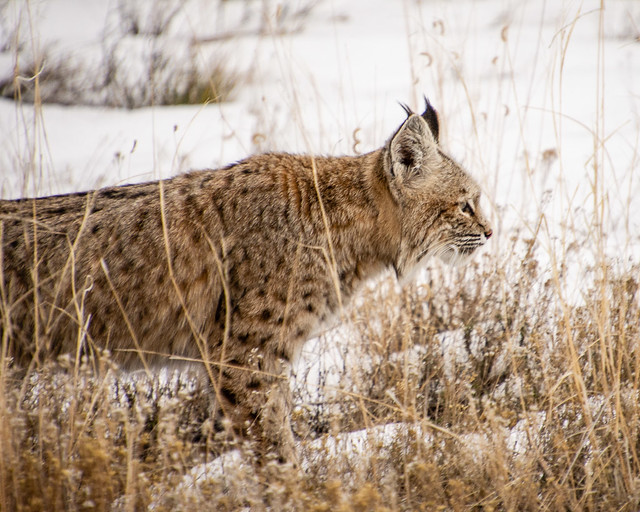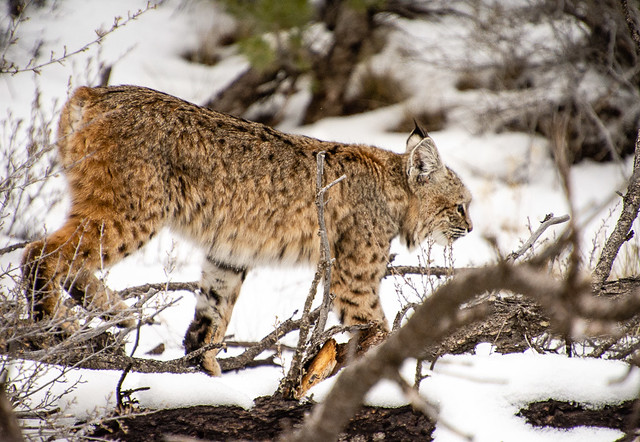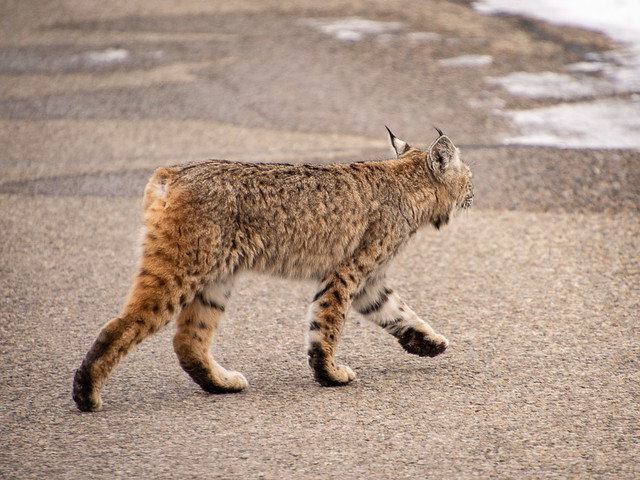I had just about finished my tour of Mesa Verde National Park (more on that later) when I saw movement at the side of the road. It was a lynx! Presumably the American version, Lynx rufus, a bobcat. Canada lynx (Lynx canadensis) are more adapted to snow, with bigger paws.

I debated whether it was worth grabbing my camera and getting out of the car, but I figured it was worth a try. The road was narrow with nowhere to park, but there wasn't much traffic, so I just pulled over and stopped. Amazingly, it was still visible, moving parallel to the road. My first few shots were in hope of proof. It was a good thing they weren't the only images I got, since they were pretty much unrecognizable through heavy bush.


It knew I was there, stopping several times to look at me. But it was moving slowly and obviously wasn't afraid of me. Another car showed up and the bobcat moved further from the road but didn't disappear. I wondered why it hadn't taken off, but then it emerged from the bush and crossed the road, obviously what it had been aiming for all along. The other car had stopped to see what I was photographing. They got a good look as it crossed the road.


I snapped lots of photos but I had no idea if they'd turn out. There wasn't much light and it was moving, and there were trees and bushes in the way. I realized afterwards that the exposure would be off because of the snowy background. When I arrived at my hotel and settled in the lounge with a glass of wine, I had to pull out my laptop and camera to see what I got. (No doubt people thought I was checking Facebook) Lots of the shots were out of focus and blurred. But excitingly, a few of them turned out pretty well. I would have been happy just to see a bobcat, to get some photos was a definite bonus! I even had to show my waitress the photos, although she wasn't as excited as I was :-)
I remember thinking it looked quite orange, which shows up in some shots more than others. I love the black tufts of hair on the ears. Apparently bobcat are active mostly at twilight, but in the winter they become more active during the day since that's when their prey is active.
Lynx were subject to heavy hunting in the past, but still managed to maintain their numbers. But they are facing a bigger problem now with habitat loss, since they need large ranges.


I debated whether it was worth grabbing my camera and getting out of the car, but I figured it was worth a try. The road was narrow with nowhere to park, but there wasn't much traffic, so I just pulled over and stopped. Amazingly, it was still visible, moving parallel to the road. My first few shots were in hope of proof. It was a good thing they weren't the only images I got, since they were pretty much unrecognizable through heavy bush.


It knew I was there, stopping several times to look at me. But it was moving slowly and obviously wasn't afraid of me. Another car showed up and the bobcat moved further from the road but didn't disappear. I wondered why it hadn't taken off, but then it emerged from the bush and crossed the road, obviously what it had been aiming for all along. The other car had stopped to see what I was photographing. They got a good look as it crossed the road.


I snapped lots of photos but I had no idea if they'd turn out. There wasn't much light and it was moving, and there were trees and bushes in the way. I realized afterwards that the exposure would be off because of the snowy background. When I arrived at my hotel and settled in the lounge with a glass of wine, I had to pull out my laptop and camera to see what I got. (No doubt people thought I was checking Facebook) Lots of the shots were out of focus and blurred. But excitingly, a few of them turned out pretty well. I would have been happy just to see a bobcat, to get some photos was a definite bonus! I even had to show my waitress the photos, although she wasn't as excited as I was :-)
I remember thinking it looked quite orange, which shows up in some shots more than others. I love the black tufts of hair on the ears. Apparently bobcat are active mostly at twilight, but in the winter they become more active during the day since that's when their prey is active.
Lynx were subject to heavy hunting in the past, but still managed to maintain their numbers. But they are facing a bigger problem now with habitat loss, since they need large ranges.

No comments:
Post a Comment